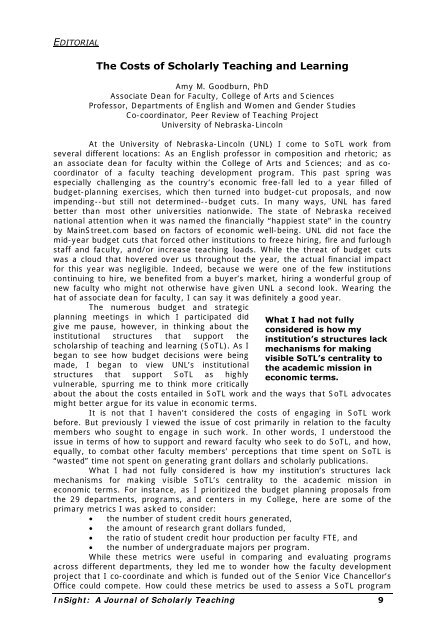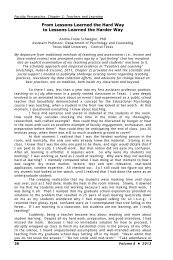The Costs of Scholarly Teaching and Learning - Insight Journal
The Costs of Scholarly Teaching and Learning - Insight Journal
The Costs of Scholarly Teaching and Learning - Insight Journal
You also want an ePaper? Increase the reach of your titles
YUMPU automatically turns print PDFs into web optimized ePapers that Google loves.
EDITORIAL<br />
<strong>The</strong> <strong>Costs</strong> <strong>of</strong> <strong>Scholarly</strong> <strong>Teaching</strong> <strong>and</strong> <strong>Learning</strong><br />
Amy M. Goodburn, PhD<br />
Associate Dean for Faculty, College <strong>of</strong> Arts <strong>and</strong> Sciences<br />
Pr<strong>of</strong>essor, Departments <strong>of</strong> English <strong>and</strong> Women <strong>and</strong> Gender Studies<br />
Co-coordinator, Peer Review <strong>of</strong> <strong>Teaching</strong> Project<br />
University <strong>of</strong> Nebraska-Lincoln<br />
At the University <strong>of</strong> Nebraska-Lincoln (UNL) I come to SoTL work from<br />
several different locations: As an English pr<strong>of</strong>essor in composition <strong>and</strong> rhetoric; as<br />
an associate dean for faculty within the College <strong>of</strong> Arts <strong>and</strong> Sciences; <strong>and</strong> as cocoordinator<br />
<strong>of</strong> a faculty teaching development program. This past spring was<br />
especially challenging as the country’s economic free-fall led to a year filled <strong>of</strong><br />
budget-planning exercises, which then turned into budget-cut proposals, <strong>and</strong> now<br />
impending--but still not determined--budget cuts. In many ways, UNL has fared<br />
better than most other universities nationwide. <strong>The</strong> state <strong>of</strong> Nebraska received<br />
national attention when it was named the financially “happiest state” in the country<br />
by MainStreet.com based on factors <strong>of</strong> economic well-being. UNL did not face the<br />
mid-year budget cuts that forced other institutions to freeze hiring, fire <strong>and</strong> furlough<br />
staff <strong>and</strong> faculty, <strong>and</strong>/or increase teaching loads. While the threat <strong>of</strong> budget cuts<br />
was a cloud that hovered over us throughout the year, the actual financial impact<br />
for this year was negligible. Indeed, because we were one <strong>of</strong> the few institutions<br />
continuing to hire, we benefited from a buyer’s market, hiring a wonderful group <strong>of</strong><br />
new faculty who might not otherwise have given UNL a second look. Wearing the<br />
hat <strong>of</strong> associate dean for faculty, I can say it was definitely a good year.<br />
<strong>The</strong> numerous budget <strong>and</strong> strategic<br />
planning meetings in which I participated did<br />
give me pause, however, in thinking about the<br />
institutional structures that support the<br />
scholarship <strong>of</strong> teaching <strong>and</strong> learning (SoTL). As I<br />
began to see how budget decisions were being<br />
made, I began to view UNL’s institutional<br />
structures that support SoTL as highly<br />
vulnerable, spurring me to think more critically<br />
What I had not fully<br />
considered is how my<br />
institution’s structures lack<br />
mechanisms for making<br />
visible SoTL’s centrality to<br />
the academic mission in<br />
economic terms.<br />
about the about the costs entailed in SoTL work <strong>and</strong> the ways that SoTL advocates<br />
might better argue for its value in economic terms.<br />
It is not that I haven’t considered the costs <strong>of</strong> engaging in SoTL work<br />
before. But previously I viewed the issue <strong>of</strong> cost primarily in relation to the faculty<br />
members who sought to engage in such work. In other words, I understood the<br />
issue in terms <strong>of</strong> how to support <strong>and</strong> reward faculty who seek to do SoTL, <strong>and</strong> how,<br />
equally, to combat other faculty members’ perceptions that time spent on SoTL is<br />
“wasted” time not spent on generating grant dollars <strong>and</strong> scholarly publications.<br />
What I had not fully considered is how my institution’s structures lack<br />
mechanisms for making visible SoTL’s centrality to the academic mission in<br />
economic terms. For instance, as I prioritized the budget planning proposals from<br />
the 29 departments, programs, <strong>and</strong> centers in my College, here are some <strong>of</strong> the<br />
primary metrics I was asked to consider:<br />
• the number <strong>of</strong> student credit hours generated,<br />
• the amount <strong>of</strong> research grant dollars funded,<br />
• the ratio <strong>of</strong> student credit hour production per faculty FTE, <strong>and</strong><br />
• the number <strong>of</strong> undergraduate majors per program.<br />
While these metrics were useful in comparing <strong>and</strong> evaluating programs<br />
across different departments, they led me to wonder how the faculty development<br />
project that I co-coordinate <strong>and</strong> which is funded out <strong>of</strong> the Senior Vice Chancellor’s<br />
Office could compete. How could these metrics be used to assess a SoTL program<br />
InSight: A <strong>Journal</strong> <strong>of</strong> <strong>Scholarly</strong> <strong>Teaching</strong> 9
that is focused on helping faculty improve teaching across an institution? How can a<br />
program that does not directly produce student credit hours, that does not visibly<br />
generate grant dollars, that does not directly increase the number <strong>of</strong> student<br />
majors, claim centrality to the institution’s academic mission?<br />
A February meeting with the Senior Vice Chancellor’s team posed similar<br />
questions about this program, which supports faculty throughout a year to<br />
document <strong>and</strong> make visible teaching <strong>and</strong> learning in a target course. While the<br />
SVCAA’s Office has been highly supportive <strong>of</strong> this program (funding it to the tune <strong>of</strong><br />
about $80,000 per year), this year the team requested more quantitative data that<br />
the project is having a direct impact on student learning. While we have collected<br />
survey data from previous faculty participants demonstrating that over 94% feel<br />
that the project has helped them to 1) better define course goals, 2) identify <strong>and</strong><br />
articulate learning objectives, 3) revise course design, <strong>and</strong> 4) better articulate their<br />
expectations for students’ learning, we still haven’t figured out a way to collect data<br />
that shows a direct impact on students’ learning. We haven’t developed a way to<br />
speak directly to the metrics that the university is using to assess economic impact<br />
in relation to academic mission.<br />
From its inception SoTL work has relied on collecting data <strong>and</strong> evidence to<br />
make arguments about what constitutes best practices in teaching <strong>and</strong> learning.<br />
Such work has been framed as systematic <strong>and</strong> ongoing, cycling back into practice<br />
for continuous improvement <strong>of</strong> teaching <strong>and</strong> learning, <strong>and</strong> making such work public<br />
<strong>and</strong> available for use by others, both institutionally <strong>and</strong> disciplinarily. But I suggest<br />
that in the present academic climate, SoTL advocates need to be more concrete<br />
about how to frame SoTL’s benefits in economic terms.<br />
Lee Shulman (2000), former president <strong>of</strong> the Carnegie Foundation, has<br />
similarly argued for the need to engage in policy discussions about SoTL’s economic<br />
value:<br />
Those who make policies <strong>and</strong> approve budgets for our institutions<br />
are increasingly asking for evidence that we are making<br />
measurable progress toward our educational goals…. I envisage a<br />
scholarship <strong>of</strong> teaching <strong>and</strong> learning <strong>of</strong>fering the kinds <strong>of</strong> evidence<br />
that can be powerful in these policy <strong>and</strong> free market discussions.<br />
(p. 52)<br />
So how can those <strong>of</strong> us who care about SoTL work help educate university decisionmakers<br />
about its economic value?<br />
One example was illustrated in the March 13 th 2009 edition <strong>of</strong> <strong>The</strong><br />
Chronicle <strong>of</strong> Higher Education. In an editorial titled “On the Bottom Line, Good<br />
<strong>Teaching</strong> Tops Good Research,” Frank<br />
Heppner, an honors pr<strong>of</strong>essor <strong>of</strong> biological<br />
sciences at the University <strong>of</strong> Rhode Isl<strong>and</strong>,<br />
compares the money that faculty at his<br />
institution generate with grants to money that<br />
faculty with strong teaching practices<br />
generate in tuition when they retain students.<br />
Heppner (2009) argues that by retaining five<br />
But I suggest that in the<br />
present academic climate,<br />
SoTL advocates need to be<br />
more concrete about how to<br />
frame SoTL’s benefits in<br />
economic terms.<br />
students who normally would drop out each semester, his teaching recovers about<br />
$250,000 in lost tuition, a sum comparable to the average grant earners at his<br />
school.<br />
Heppner’s overall argument is that institutions benefit economically by<br />
supporting faculty teaching development (2009). What I also find valuable about<br />
Heppner’s argument, however, is that the approach he took to retain his students<br />
was systematic, documented, <strong>and</strong> based on collection <strong>of</strong> data--the same principles<br />
that undergird scholarly approaches to teaching <strong>and</strong> learning. Although he does not<br />
use the language <strong>of</strong> SoTL within his editorial, the headline easily could have been<br />
titled “<strong>Scholarly</strong> <strong>Teaching</strong> is Cost-Effective” or “SoTL Approaches Retain Students<br />
<strong>and</strong> Save Money.” Heppner’s argument raises questions that I think SoTL advocates<br />
need to consider more fully. How can we ground our claims for SoTL’s importance<br />
10 Volume 4 ● 2009
within terms that policy makers <strong>and</strong> university administrators can underst<strong>and</strong> <strong>and</strong><br />
act upon? What are the economic benefits to institutions that value <strong>and</strong> reward<br />
SoTL? And what are the costs to institutions that do not? As a teacher,<br />
administrator, <strong>and</strong> faculty developer, these are the SoTL questions that I am<br />
continuing to wrestle with as I prepare for the next academic year.<br />
References<br />
Heppner, F. (2009, March 13). On<br />
the bottom line: Good teaching tops<br />
good research. <strong>The</strong> Chronicle <strong>of</strong><br />
Higher Education, pp. A72.<br />
Shulman, L. (2000). From minsk to<br />
pinsk: Why a scholarship <strong>of</strong> teaching<br />
<strong>and</strong> learning? <strong>Journal</strong> <strong>of</strong> Scholarship<br />
<strong>of</strong> <strong>Teaching</strong> <strong>and</strong> <strong>Learning</strong>, 1, 48-53.<br />
Amy Goodburn is Pr<strong>of</strong>essor <strong>of</strong> English <strong>and</strong> Associate Dean for Faculty in the College<br />
<strong>of</strong> Arts <strong>and</strong> Sciences at the University <strong>of</strong> Nebraska-Lincoln. Her research <strong>and</strong><br />
teaching interests include critical <strong>and</strong> multicultural pedagogies, ethnographic <strong>and</strong><br />
teacher research, <strong>and</strong> documenting <strong>and</strong> assessing teaching <strong>and</strong> learning in<br />
postsecondary education. Her recent books include Inquiry into the College<br />
Classroom: A Journey Toward <strong>Scholarly</strong> <strong>Teaching</strong> (with Paul Savory <strong>and</strong> Amy<br />
Burnett) <strong>and</strong> Making <strong>Teaching</strong> <strong>and</strong> <strong>Learning</strong> Visible: Peer Review <strong>and</strong> Course<br />
Portfolios (with Dan Bernstein, Paul Savory, <strong>and</strong> Amy Burnett). Since 2001 she has<br />
co-coordinated UNL's Peer Review <strong>of</strong> <strong>Teaching</strong> Project, a year-long program that<br />
supports faculty in documenting <strong>and</strong> assessing student learning. In 2002, Dr.<br />
Goodburn was inducted into UNL's Academy <strong>of</strong> Distinguished Teachers.<br />
InSight: A <strong>Journal</strong> <strong>of</strong> <strong>Scholarly</strong> <strong>Teaching</strong> 11





